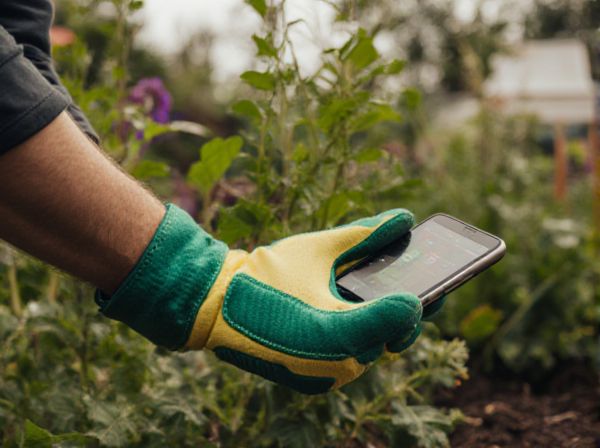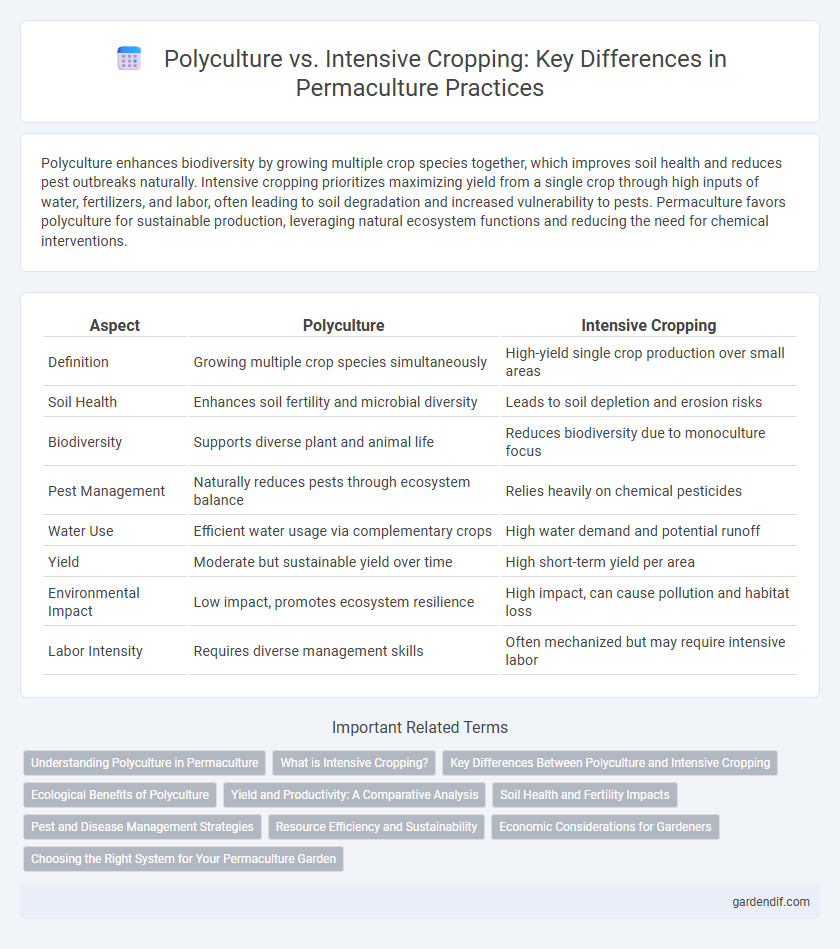
Polyculture vs Intensive Cropping Illustration
Polyculture enhances biodiversity by growing multiple crop species together, which improves soil health and reduces pest outbreaks naturally. Intensive cropping prioritizes maximizing yield from a single crop through high inputs of water, fertilizers, and labor, often leading to soil degradation and increased vulnerability to pests. Permaculture favors polyculture for sustainable production, leveraging natural ecosystem functions and reducing the need for chemical interventions.
Table of Comparison
| Aspect | Polyculture | Intensive Cropping |
|---|---|---|
| Definition | Growing multiple crop species simultaneously | High-yield single crop production over small areas |
| Soil Health | Enhances soil fertility and microbial diversity | Leads to soil depletion and erosion risks |
| Biodiversity | Supports diverse plant and animal life | Reduces biodiversity due to monoculture focus |
| Pest Management | Naturally reduces pests through ecosystem balance | Relies heavily on chemical pesticides |
| Water Use | Efficient water usage via complementary crops | High water demand and potential runoff |
| Yield | Moderate but sustainable yield over time | High short-term yield per area |
| Environmental Impact | Low impact, promotes ecosystem resilience | High impact, can cause pollution and habitat loss |
| Labor Intensity | Requires diverse management skills | Often mechanized but may require intensive labor |
Understanding Polyculture in Permaculture
Polyculture in permaculture involves growing multiple complementary plant species in the same space to mimic natural ecosystems, enhancing biodiversity and resilience. Unlike intensive cropping, which focuses on maximizing yield from a single crop often at the expense of soil health, polyculture promotes nutrient cycling, pest control, and sustainable soil management. This approach reduces reliance on synthetic inputs while improving overall ecosystem stability and productivity.
What is Intensive Cropping?
Intensive cropping is an agricultural practice that maximizes crop yield per unit area through high inputs of labor, fertilizers, and irrigation, often relying on monoculture systems. Unlike polyculture, which emphasizes biodiversity and ecosystem balance, intensive cropping prioritizes short-term productivity and resource efficiency. This method can lead to soil degradation and increased vulnerability to pests if not managed sustainably.
Key Differences Between Polyculture and Intensive Cropping
Polyculture involves cultivating multiple crop species simultaneously within the same space, enhancing biodiversity, soil health, and pest resilience, while intensive cropping focuses on maximizing yield from a single crop through high inputs like fertilizers and pesticides. Polyculture promotes natural ecosystem functions and reduces vulnerability to pests, whereas intensive cropping relies heavily on external inputs and often leads to soil degradation. The key difference lies in sustainability and ecosystem balance versus short-term productivity and monoculture dependency.
Ecological Benefits of Polyculture
Polyculture enhances biodiversity by cultivating multiple plant species simultaneously, leading to improved pest control and natural disease resistance compared to monoculture-intensive cropping systems. This diversity promotes healthier soil ecosystems, increasing nutrient cycling and organic matter retention, which reduces the need for chemical fertilizers. The ecological stability of polyculture fosters resilience to climate variability, supports beneficial insects, and enhances overall farm sustainability.
Yield and Productivity: A Comparative Analysis
Polyculture systems enhance yield stability and biodiversity by cultivating multiple complementary crops simultaneously, optimizing nutrient use and pest control naturally. Intensive cropping prioritizes maximizing output per unit area through monoculture and high input use, often resulting in higher short-term yields but increased vulnerability to pests and soil degradation. Comparative analysis reveals polyculture's sustainable productivity gains over time, while intensive cropping achieves peak yields more rapidly but with ecological costs.
Soil Health and Fertility Impacts
Polyculture enhances soil health by promoting biodiversity, improving nutrient cycling, and reducing pest outbreaks, which leads to sustainable fertility over time. Intensive cropping often depletes soil nutrients rapidly, causes erosion, and disrupts microbial communities, resulting in decreased soil quality and the need for synthetic inputs. Integrating diverse plant species in polyculture systems supports resilient soil ecosystems and long-term fertility, making it a more sustainable approach compared to monoculture-intensive practices.
Pest and Disease Management Strategies
Polyculture integrates diverse plant species to naturally disrupt pest cycles and reduce disease spread by enhancing biodiversity and promoting beneficial predator habitats. Intensive cropping often relies on chemical inputs and crop rotation schedules to manage pests and diseases, which can lead to resistance and soil degradation over time. Employing polyculture principles in pest and disease management supports ecosystem resilience and sustainable agricultural productivity.
Resource Efficiency and Sustainability
Polyculture maximizes resource efficiency by cultivating diverse plant species that optimize nutrient cycling, enhance soil health, and reduce pest pressures, promoting long-term sustainability. Intensive cropping often relies on monocultures with high chemical inputs, which can degrade soil fertility and increase vulnerability to pests, posing sustainability challenges. Integrating polyculture practices supports resilient ecosystems and sustainable agricultural productivity through efficient use of natural resources.
Economic Considerations for Gardeners
Polyculture enhances economic resilience by diversifying crop yields, reducing dependency on single-market fluctuations, and optimizing space with complementary plants that improve soil health and reduce pest control costs. Intensive cropping maximizes short-term profits through high-density planting and rapid turnover but often incurs higher input costs for fertilizers, pesticides, and soil amendments, potentially leading to diminishing returns over time. Gardeners practicing permaculture benefit economically by balancing these methods to sustain productivity while minimizing expenses and ecological impact.
Choosing the Right System for Your Permaculture Garden
Polyculture enhances biodiversity by integrating multiple plant species, promoting pest resistance and soil health in permaculture gardens. Intensive cropping maximizes yield per area through focused planting but may increase soil depletion and pest vulnerability. Selecting the right system depends on garden size, resource availability, and long-term sustainability goals within your permaculture design.
Polyculture vs Intensive Cropping Infographic

 gardendif.com
gardendif.com